| Matthew Biggar Walker
(1873-1950): Wolverhampton friend of Sir Frank Brangwyn
and patron of artists and arts |
| It is well known in Wolverhampton that the Art
Gallery and its collection were established as a result
of efforts and generous donations undertaken by several
local entrepreneurs and benefactors of the Victorian
period, such as Sidney Cartwright and his wife Maria
Christiana, Philip Horsman and Paul Lutz. Local art
patrons of the 20th century and their
involvement in the further development of the collection
are less known. Nevertheless, their influence appears
equally important to that of these predecessors. Their
efforts brought to Wolverhampton a strong collection of
works by 20th century artists and secured
their relations with the Gallery. One of such patrons
whose efforts helped to establish the national
reputation of Wolverhampton Art Gallery was Matthew
Biggar Walker (1873-1950). Son of a travelling draper,
he was born in Dudley, and started his career as a
school teacher. He moved to Wolverhampton by 1900, when
he married Ada Frances Boulton (1870-1953), a daughter
of a local butcher. Somehow surprisingly, he initially
established himself here as a tailor and draper on his
own account[1],
but very soon returned to teaching and eventually became
a superintendent of night classes at Queen Street Chapel
and a Sunday school teacher at Red Cross-Street school.
From 1910 and until their death, Matthew and Ada Walker
lived permanently in 1, Park Crescent.[2]
|
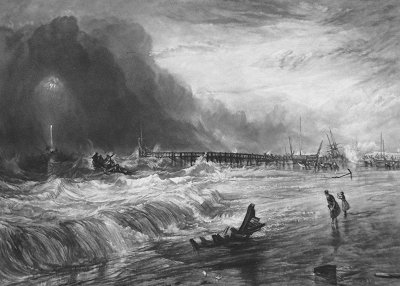
Donated by M. B.
Walker to WAG in 1919:
Frank Short.
Vessel in Distress (after JMW Turner). |
He developed a strong interest in art and
established close relations with many living artists of
the Black Country, such as Frank Short, Sidney Causer,
William Strang and Albert Goodwin.
In the 1910s-1920s Walker became known as an art
collector and art dealer.[3]
His name was first recorded in the Gallery’s acquisition
book in 1919, when he donated two works on paper by
Frank Short. |
| In November 1922
Walker was appointed a member of the Art Gallery and
Public Library Committee[4]
and for decades he remained its active member, loaning
works from his own collection to the exhibitions at the
Gallery, organising loans and donations from other local
collectors, communicating with artists and their
families, establishing links with museums and galleries
across the region. |
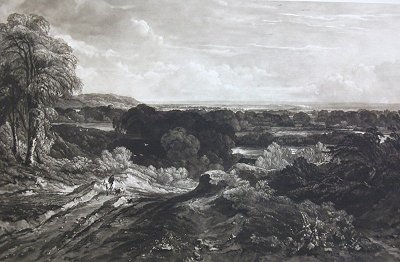
Donated
by M. B. Walker to WAG in 1919:
Frank Short. The
Landscape. |
| In 1924, he donated six drawings by Edward Poynter
to Birmingham Museum & Art Gallery, thus it is not
surprising that next year, when Walker organised in
Wolverhampton the Albert Goodwin (1845-1932) exhibition,
its formal opening was performed by Sir Whitworth
Wallis, the first director of BM & AG and son of
George Wallis of
Wolverhampton. The exhibition included ninety one
artworks and was described as ‘the largest and the
most representative collection so far.’ Sir
Whitworth said that Albert Goodwin was a master of many
methods, and that was the finest exhibition of his works
he had seen[5].
|

Donated
by M. B. Walker in 1925: Albert Goodwin. Sermon in the Hayfield. Simplon. 1882. |
Walker loaned for that exhibition two Goodwin
paintings from his own collection. One of these, ‘Sermon
in the Hayfield, Simplon’ he eventually donated to the
Gallery, the second, ‘The City of Glittering Light’, was
later purchased from him by the Art Committee for £150.
In 1926 he secured for Wolverhampton the bequest of his
late friend, Henry Watson Smith of Stourbridge: a view
of Winchester by Albert Goodwin, ‘French River Scene’ by
Sir Alfred East, and an etching by Frank Brangwyn of
Barnard Castle.[6]
|
| In 1929, he
organised at the Gallery a loan exhibition of Worcester porcelain
from Alderman Bantock. In this way, he anticipated the development
of Wolverhampton Museum Service, a part of which Bantock House would
become years later.
Today, the Bantock porcelain collection has been
preserved at Wolverhampton Art Gallery and displayed at both Bantock
House and the Art Gallery.
In the same year, he gave to the Gallery a
watercolour by Sidney Causer and an etching by William Strang.[7] |

Purchased from M. B. Walker in 1925: Albert Goodwin. The
City of Glittering Light. 1905 |
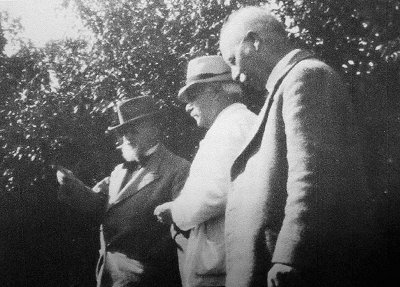
Frank Brangwyn, Frank Short, and M. B. Walker at Brangwyn’s home. C.1933.
Courtesy of Libby Horner. |
This gift was followed by 18 mezzotints and etchings by Frank Short
given to Bushbury Branch Library in the 1930s.[8]
In fact, Walker was a local dealer for Frank Short: the heading of
Walker’s letter paper reads: ‘Fine Art and Literary Valuer. The
Studio, 20 Wolverhampton Street, Dudley.
Engraved works of Sir Frank
Short. RA,
PRE.' [9] |
| But the most important
and long-lasting, the subject of Walker’s joy and pride, were his
relations with Sir Frank Brangwyn.
His first visit to Brangwyn’s
London home, to see his sketches for
Jefferson City Court House, was recorded in 1922.
The result of this visit was close and life-long
friendship between the London artist and Wolverhampton
art connoisseur.
In 1981, Birmingham Museum & Art Gallery purchased
from Wolverhampton art dealer John R. Beards[10]
a correspondence consisting of 250 letters, all but eight of them
from Frank Brangwyn to Matthew Biggar Walker covering a period from
November 1922 to May 1946[11].
About forty letters contain humorous sketches commenting their
meetings and relations.
One of them, depicting a woman ‘seen at the nudist camp at
Wolverhampton’[12],
suggests that not only Walker went to London and Suffolk to see
Brangwyn, but Brangwyn also visited Wolverhampton. |
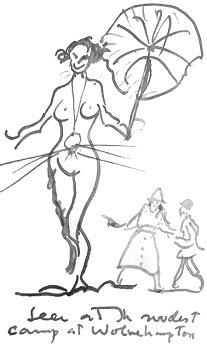
Frank Brangwyn’s
sketch in his letter to M. B. Walker: “Seen at the nudist
camp at Wolverhampton”.
©
BM & AG. |

Frank Brangwyn’s sketch in his letter to M. B. Walker:
“Christmas – F[rank] B[rangwyn] serves a pudding on a
sketch. M[att] W[alker] filling up with sketches” © BM &
AG. |
Along with documents
which have been preserved at Wolverhampton Art Gallery and Archives,
they confirm that Walker acted as a mediator between Frank Brangwyn
and the Gallery, establishing and encouraging Brangwyn’s direct
patronage of the Gallery.
In May 1930, ‘Mr. Matthew Biggar Walker
reported that Mr. Frank Brangwyn, RA, the famous artist, had offered
to present to the Art Gallery some of his drawings.’[13]
|
| This present consisted of Brangwyn’s seven original drawings to
illustrate the 1919 edition of ‘Les Villes Tentaculaires’ by Emile
Verhaeren. |
| In April next year,
Walker wrote to the Curator of the Gallery: ‘When I was with Sir
Brangwyn a week ago, he gave me for the Gallery the original drawing
and the etching of ‘St Leonard’s Abbey near Tours’. /…/ I was very
pleased when he so readily made another gift. He said I could give
them to Dudley or Wolverhampton, but I thought our gallery here more
fitting for them.’[14]
Another easy gift was a watercolour by Sir Alfred East ‘The Silver
Seine, France’ the historic value of which is particularly important
today because it bears an inscription: “Alfred East, to my friend
F. Brangwyn, 1.3.1903.”[15] |
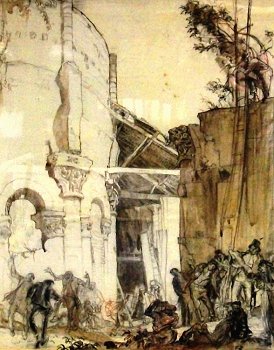
Donated by Frank Brangwyn in 1931
“through the
instrumentality of Mr.
Walker”:
F. Brangwyn. St Leonard’s
Abbey near Tours. |

Donated by Frank Brangwyn in 1931 “through the instrumentality of Mr. Walker”:
Sir Alfred East. ‘The Silver Seine, France’. Inscribed:
“Alfred East, to my friend F. Brangwyn, 1.3.1903.”
|
In 1932, Brangwyn
presented to the Gallery a bronze bust of himself by Alfred Drury
(1859-1944). “It was modelled on Mr. Brangwyn’s fifty-first
birthday and presented to Mrs Brangwyn by a great admirer of her
husband’s work and skill. /…/ Since the death of Mrs Brangwyn, Mr. Brangwyn decided that it shall find its permanent resting place in
the Wolverhampton collection.”[16]
In the same year other eight lithographs by Brangwyn were added to
the gallery collection ‘through the instrumentality of Mr. M. B.
Walker’. |
| In 1932, Walker ‘offered a very fine collection of drawings
by Sir Frank Brangwyn for the purpose of exhibition.’[17]
From this modest proposal, a large-scale exhibition emerged, in the
development of which Walker played an instrumental role. It was then
considered one of the most important exhibitions that had ever held
in Wolverhampton.
There were 185 works on show from which only eight
were given by Brangwyn, but 157 items were loaned by M. B. Walker from
his own private collection. He mentioned at the opening that it had
taken him ten years to get the collection together.
The reviewer of
the ‘Express and Star’ noticed that ‘Mr. Walker had persuaded the
artist to lend a number of important paintings that made the
exhibition thoroughly representative.’[18]
|

Purchased in 1933
from the Brangwyn exhibition organised by M. B. Walker.
Frank Brangwyn. The Brass Pot. |
| It was acknowledged that ‘it was one of the most important
exhibitions they had ever held in the town, and had only been
possible through Mr. M. B. Walker, who was a personal friend of Mr. Brangwyn.’[19]
From this exhibition, Brangwyn’s painting ‘The Brass Pot’ was
purchased for the Gallery for £300. Next year, ‘through the
instrumentality of Mr. M. B. Walker’ the Gallery received from
Brangwyn a large Sevres vase which ‘previously had been presented
to him by the French Government in recognition of his services to
art in France.’[20]
In 1934-1935,
Brangwyn donated a number of his works to Dudley, and two
exhibitions of Brangwyn’s works from the Walker collection were
organised at Dudley Art Gallery. Its curator C. V. Mackenzie wrote: ‘The
inhabitants of Dudley have much to be thankful for /…/ the insight
of Mr. Matthew Biggar Walker, their permanent collection of pictures
have been enriched by a fine series of drawings and lithographs by
Brangwyn.’[21]
Promoting
Brangwyn’s works and his own collection, M. B. Walker worked on
national level: after Wolverhampton and Dudley, he organised the Brangwyn exhibition in Liverpool, and Frank Lambert, the Director of
Walker Art Gallery, wrote in April 1935 to M. B. Walker: ‘…This is
probably the only gallery which has the space to show indefinitely
/…/ his own large works and your collection of his work. All the
framed works in your collection were hung immediately we received
them. I was waiting until Brangwyn’s pictures arrived before
including the whole of your collection and his in one large and
handsome Brangwyn Exhibition.’[22]
In 1939, an exhibition was organised at Sunderland Public Art
Gallery, Museum and Library, to which ‘a collection of paintings,
etchings, drawings, etc. by Frank Brangwyn, was lent by M. B. Walker of
Wolverhampton.’[23]
One of the last
Walker’s actions of friendship towards Sir Frank Brangwyn was the
delivery of the artist’s self-portrait to the Uffizi Gallery in
Florence. Commissioned by the Uffizi in 1910, it was for many years
in M. B. Walker’s possession, until in 1949 he brought the portrait to
Florence.[24]
Walker’s influence
was so strong that Brangwyn continued to pay his attention to
Wolverhampton even after M B. Walker’s death in 1950. In 1950 and
1951, Brangwyn again gave to the Gallery twenty five and twenty
three his drawings respectively. Eventually, one of exhibition
galleries at WAG was named ‘Brangwyn Room’. There is another
group of artworks in the Gallery collection which is associated with
Frank Brangwyn: a series of oil paintings and drawings by the
Pre-Raphaelite artist Frederic-James Shields (1833-1911), which is
recorded in the 1974 ‘Catalogue of Oil Paintings in the Permanent
Collection of Wolverhampton Art Gallery’ as given in 1950 by Frank
Brangwyn[25].A close friend of
DG Rossetti and FM Brown, Shields was known as a painter, book
illustrator, sometimes a designer, but his most significant works
were three successive series of mural decorations for the private
chapel of W H Houldworth at Kilmarnock (1876-1880), the Chapel of
Eaton Hall, Cheshire, seat of the Dukes of Westminster (1876-1888),
and for the Chapel of the Ascension, Bayswater Road, London
(1888-1910).
For each chapel Shield provided
designs for stained glass and mosaics: for the Eaton Hall – on the
theme ‘‘Te Deum Laudamus’ and for Kilmarnock –on the theme
'The Triumph of Faith'. For the Chapel of the
Ascension which was commissioned by Mrs Emilia Russell
Gurney, the widow of judge and politician, the Recorder of London
Russell Gurney (1804–1878), he
re-used his earlier designs, but at the same time developed a
complex iconographical programme, uniting Biblical
subjects with allegorical concepts. While the initial idea of
Mrs Russell Gurney was a little decorated hall inspired by Italian
Renaissance architecture and paintings, Shields brought into this
work his intense religious feeling: ‘I feel that if Art may be
used in the service of God at all, if the fine talent may be traded
with in Christ’s mart, then there is a scope and part for it never
yet approached save in a very few exceptional examples. I feel that
if there is to be a spiritual life in this work, and welling from
it, it must be wrought in and by the spirit of life.’[26]
|
 |
|
Saved by F. Brangwyn, secured for Wolverhampton by
M. B. Walker:
Frederic Shields. Images of Prophets from the Old Testament.
1880s. |
|
 |
|
Images of prophets
and apostles which had been executed at the Eaton Chapel in stained
glass and stone mosaics appeared at the Chapel of the Ascension as
oil paintings on canvas attached to slabs of
slate.[27]
The Chapel was opened in October 1897, just before the death of Mrs
Russell Gurney, but all artistic work was completed only in 1910.
Shields died next year.
In the 1880s, Frank
Brangwyn was directly associated with Frederick Shields through A. H. Mackmurdo and William Morris. He was attentive and analytical
towards the achievements of the elder generation of Victorian
artists and considered Shields one of the best Victorian painters.
He had a very high opinion of the Shields’ work at the Chapel of the
Ascension: ‘The stuff he did for the Chapel of Ascension /…/ is
very fine – irrespective of fashion and the changing of artistic
outlook. These decorations are, in every sense, the most complete
examples of decoration done in England.’[28]
The Chapel of the
Ascension was severely damaged in London Blitz of 1940 and Shields’
mosaics and paintings perished. Brangwyn mourned the destruction of
the Chapel: ‘It is sad beyond words that the beautiful work he
did for the Chapel of the Ascension has been destroyed by bombs… and
so much else! It makes my heart bleed to think of all this.’[29]
According to
Shields’ will, he wanted more than seventy cartoons of designs which
remained in his studio, to be placed in some public institution
which would frame and hang the whole series. The executors of
Shields’ will gave them finally to the Young Men’s Christian
Association (YMCA) for their headquarters in Tottenham Court Road,
London. After destruction of the Chapel of the Ascension, the
cartoons at YMCA became lucky survivors reminding of Shields’
large-scale and harmonious artistic plan.
In 1944, Brangwyn
discovered their location at YMCA. He wrote that his friend William
de Belleroche ‘found them in the cellar. They told him they would
like to get rid of them. I, at once, for the sake of Shields memory
bought them, and have been placing them in such places, as the
British Museum, SK Museum (South Kensington, today Victoria &
Albert. – OB), Fitzwilliam, Walthamstow, Hull, Birmingham,
Ashmolean Oxford etc. etc. so one hopes that some will survive, they
are very fine and highly finished, about 5 feet high many of them.
Rossetti, Madox Brown, Ruskin and others thought highly about him
and his work. One would have thought that the YMCA was the very
place to show such things as they are fine Art, and have in most
cases a spiritual message, but they told my friend that such
subjects had no interest for them and the young. When one is told
this by people who have the control and the opportunity of
teaching in the right directions, one feels it is rather hopeless.
It shows the spirit of our times…’[30]
Besides already mentioned institutions, on Brangwyn’s list were
museums and galleries of Leeds, Cardiff, Liverpool, Manchester,
Nottingham, Dudley, Wolverhampton[31].
It seems that the task was not easy, and there were museums whose
feelings about Shields’ works were similar to those of people of
YMCA. While Fitzwilliam, Walthamstow, Manchester and British Museum
have today in their collections a few Shields’ works donated by
Brangwyn in 1944, the Ashmolean, Victoria & Albert, Liverpool and
Cardiff museums do not. It might be the reason why Wolverhampton Art
Gallery holds not one or two, but impressive number of sixteen
Shields’ cartoons - Matthew Biggar Walker took artworks which were
rejected by other potential recipients.
Wolverhampton Art
Gallery and its Art Committee, however, also seemed to feel
negatively about this acquisition: quite embarrassingly, this gift
was not recorded in the Gallery documentation, acquisition books and
any other existing paperwork. It was also not recorded in the
Minutes of the Art Committee, and it was mentioned neither in local
newspapers, nor in the national professional publications, such as
Museums Journal or The Year’s Art. The date of the
acquisition ‘1950’ given in the 1974 Catalogue contradicts with
Brangwyn’s 1944 correspondence on distribution of Shields’
paintings.
The conclusion is
that Shields cartoons were probably given to the Gallery in 1944
through M. B. Walker, but not acquired. The acquisition record was
developed much later, in the 1970s, when the curators audited the
collection, preparing their catalogue to publication. The date of
acquisition ‘1950’ was based on the recorded Brangwyn’s gift of
twenty-five his drawings. Another possibility is that the cartoons
remained at the Walker’s and were transferred to the Gallery after
his death in 1950.
Wolverhampton and
its Art Gallery benefited for decades from the attention and
generosity of Frank Brangwyn, but it was M. B. Walker who encouraged Brangwyn gifts to Wolverhampton and brought national recognition to
the Gallery. Thanks to him, the Gallery possesses today not only a
representative selection of works by Sir Frank Brangwyn and other
significant British artists of the first part of the 20th
century, but also a magnificent series of the Pre-Raphaelite master
Frederic Shields, a reminder of the artistic and spiritual longings
of the Victorian era and of the tragic artistic losses in time of
war. Regarding the Shields cartoons, Walker probably shared Frank
Brangwyn’s emotions about which he wrote: ‘I am happy in feeling
that we have done the best possible to save the good of a good and
Fine artist.’[32]
|
References
[1] 1901 census.
[2] Express and Star, March 29, 1950.
[3] Ibid; The Year’s Art 1940.
[4] WOL-C-AGPL/1. 20.11.1922.
[5] Express & Star, 22.12.1925.
[6] WOL-C-AGPL/2. 30.05.1926. Henry
Watson-Smith bequeathed to BM & AG a number of Japanese
woodblock prints.
[7] Acquisition book DX894/5/4.
[8] WLO-C-AGPL/3. May 1930.
[9] Watson-Cmith. Donor’s file.
Wolverhampton Art Gallery.
[10] John R. Beards, Tower Antiques, 175 Blackhalve Lane, Wednesfield, Wolverhampton.
[11] BM & AG. F. Brangwyn- M. B. Walker
correspondence. P89’81.
[12] BM & AG. F. Brangwin- M. B. Walker
correspondence. P89’81 – 210.
[13] WLO-C-AGPL/3. May 1930.
[14] WAG. Artist’s file ‘Frank Brangwyn’.
Letter from MBW to A. Cooper, 2.04.1931.
[15] W95. Sir Alfred East. The Silver
Seine. ©Wolverhampton Art Gallery.
[16] Express & Star, 31.05.1932.
[17] WOL-C-AGPL/4. 1932.
[18] Express & Star, March 1933.
[19] Express & Star, March 1933.
[20] Wolverhampton Local Studies. Public
Library and Art Gallery Minutes Book 6. (CMB/WOL/AGPL/5).
[21] Exhibition of Drawings and Paintings
by Frank Brangwyn lent by M. B. Walker, Esq. and David Walker,
Esq.
Dec 1934 -Jan 1935. Dudley Art Gallery.
[22] F. Lambert to M. B. Walker, 24.04.1935.
BM & AG. F. Brangwin - M. B. Walker correspondence.
P89’81 – 244.
[23] The Year’s Art. 1940. P.109.
[24] Brangwyn, Rodney. Brangwyn. London,
1978. P.149-150.
[25]
Griffiths V. and Rodgers D. A Catalogue of Oil Paintings in
the Permanent Collection of Wolverhampton Art
Gallery. 1974.
[26] Ernestine Mills. The Life and Letters
of Frederic Shields. 1833-1911. 1912. P.309.
[27]
www.1911encyclopedia.com
[28] Belleroche, W. Brangwyn’s Pilgrimage.
London, 1948. P.122
[29] Belleroche, W. Brangwyn’s Pilgrimage.
London, 1948. P.128.
[30] F.B. to Eleanor Pugh (niece of A. H. Mackmurdo). 29 May 1944. Walthamstow J697.
[31] F.B. to William de Belleroche. May
1944. Private Collection; F.B. to William de Belleroche.
10.09.1944.
Private Collection; F.B. to William de Belleroche.
Undated. Private Collection.
[32] F.B. to W. de Belleroche. 23 April 1944.
Private collection. Cit. in: Powers Alan. The murals of
Frank
Brangwyn. In: Libby Horner and Gillan Naylor [ed.]
Frank Brangwyn. 2006. P.74. |
 |
Return to
the
previous page |
|